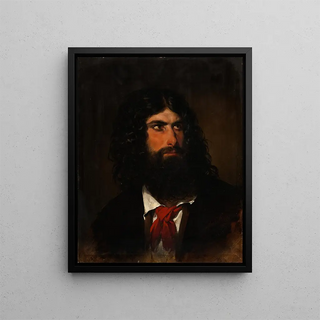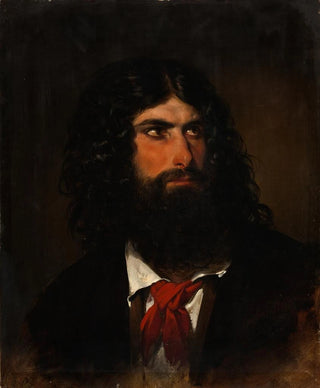Art print | Portrait of a Roman peasant - Friedrich von Amerling


View from behind

Frame (optional)
In the fascinating world of art, some works transcend time and space, captivating the mind and soul of viewers. The "Portrait of a Roman Peasant" by Friedrich von Amerling is one of those creations that, through its depth and authenticity, transports us to the heart of rural life in the 19th century. This piece, imbued with realism and delicacy, highlights not only the face of a humble peasant but also the very essence of an era when man and nature coexisted in harmony. Contemplating this art print, one feels an immediate connection with the subject, an invitation to explore the hidden stories behind each wrinkle and gaze.
Style and uniqueness of the work
Friedrich von Amerling's style is distinguished by his ability to capture light and textures with remarkable finesse. In this portrait, the painter uses a palette of soft colors, playing with shades to bring the peasant's skin to life, while emphasizing the details of his traditional clothing. The serene and contemplative expression of the model evokes a rare psychological depth, reflecting the inner richness of this simple man. The composition of the piece, centered on the peasant's face, creates an intimacy that invites the viewer to question his personal story. Amerling thus manages to transcend mere representation to offer a true study of character, where each visual element contributes to the whole, making the art print both accessible and universal.
The artist and his influence
Friedrich von Amerling, born in 1803 in Vienna, is one of the most influential painters of his time. Trained at the Vienna Academy of Fine Arts, he established himself through his exceptional talent and innovative approach to portraiture. Amerling was a passionate advocate of realism, and his work is part of an artistic movement that values authentic representation of subjects. His influence extends beyond Austrian borders, inspiring many contemporary and future artists. By highlighting figures of the people, he helped redefine the portrait as a means of social expression, allowing often overlooked characters to be celebrated.

Matte finish

View from behind

Frame (optional)
In the fascinating world of art, some works transcend time and space, captivating the mind and soul of viewers. The "Portrait of a Roman Peasant" by Friedrich von Amerling is one of those creations that, through its depth and authenticity, transports us to the heart of rural life in the 19th century. This piece, imbued with realism and delicacy, highlights not only the face of a humble peasant but also the very essence of an era when man and nature coexisted in harmony. Contemplating this art print, one feels an immediate connection with the subject, an invitation to explore the hidden stories behind each wrinkle and gaze.
Style and uniqueness of the work
Friedrich von Amerling's style is distinguished by his ability to capture light and textures with remarkable finesse. In this portrait, the painter uses a palette of soft colors, playing with shades to bring the peasant's skin to life, while emphasizing the details of his traditional clothing. The serene and contemplative expression of the model evokes a rare psychological depth, reflecting the inner richness of this simple man. The composition of the piece, centered on the peasant's face, creates an intimacy that invites the viewer to question his personal story. Amerling thus manages to transcend mere representation to offer a true study of character, where each visual element contributes to the whole, making the art print both accessible and universal.
The artist and his influence
Friedrich von Amerling, born in 1803 in Vienna, is one of the most influential painters of his time. Trained at the Vienna Academy of Fine Arts, he established himself through his exceptional talent and innovative approach to portraiture. Amerling was a passionate advocate of realism, and his work is part of an artistic movement that values authentic representation of subjects. His influence extends beyond Austrian borders, inspiring many contemporary and future artists. By highlighting figures of the people, he helped redefine the portrait as a means of social expression, allowing often overlooked characters to be celebrated.






